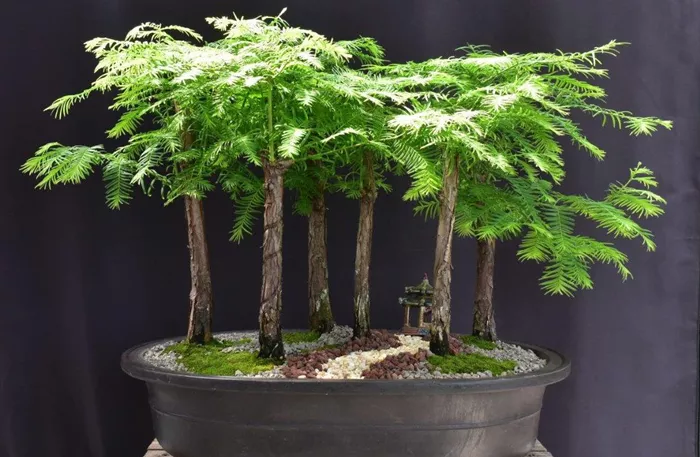Dawn Redwood (Metasequoia glyptostroboides) bonsai is a captivating and unique addition to any bonsai collection. Repotting is a crucial aspect of bonsai care, and knowing the right time to do it can significantly impact the health and growth of your Dawn Redwood bonsai.
Understanding the Dawn Redwood’s Growth Cycle
Before we determine the best time to repot, it’s essential to understand the growth cycle of the Dawn Redwood. This tree is a deciduous conifer. In spring, as the temperatures rise, it begins to break dormancy. New buds start to swell and eventually unfurl into fresh, delicate foliage. During the summer, it experiences active growth, with the leaves fully developed, photosynthesizing and helping the tree store energy. As fall approaches, the leaves change color and gradually drop, leading the tree into dormancy in winter.
Reduced Stress on the Tree
When the tree is still in a semi – dormant state in early spring, it is less likely to be severely stressed by the repotting process. The roots are not yet in full – speed growth mode, so any damage to the root system during repotting is less likely to disrupt the tree’s overall function. The tree has a better chance of recovering from the shock of being transplanted because it is not expending a lot of energy on new growth at this time.
Optimal Repotting Time
The ideal time to repot a Dawn Redwood bonsai is in early spring, just before new growth begins. There are several reasons for this. Firstly, when the tree is still in a semi – dormant state, it is less stressed by the repotting process. The roots are not yet in full – swing growth mode, so any damage to the root system during repotting will be less likely to disrupt the tree’s overall function.
Secondly, repotting in early spring gives the tree plenty of time to recover and establish new roots before the heat of summer arrives. As the weather warms up and the tree starts to grow, the fresh soil provides better access to nutrients and water, which are essential for the development of new shoots and leaves.
Signs That Your Dawn Redwood Bonsai Needs Repotting
Root Bound: If you can see roots circling around the inside of the pot or emerging from the drainage holes, it’s a clear sign that the tree has outgrown its current container and needs more space for root expansion.
Poor Growth: If your Dawn Redwood bonsai has shown stunted growth, yellowing leaves, or a general lack of vitality over the past growing season, it could be due to depleted soil nutrients or restricted root growth, both of which can be addressed by repotting.
The Repotting Process
Prepare the Tools and Materials: You’ll need a suitable new pot, bonsai soil, pruning shears, and a root hook. The new pot should be slightly larger than the current one to allow for root growth but not too large, as this can lead to over – watering.
Remove the Tree from the Old Pot: Gently tap the sides of the pot to loosen the soil. Carefully lift the tree out, trying to keep as much of the root ball intact as possible.
Prune the Roots: Use the root hook to carefully tease out and remove any dead, damaged, or overly long roots. Pruning the roots encourages new root growth and helps the tree fit better in the new pot.
Place in the New Pot: Position the tree in the new pot, adding soil around the roots. Gently tamp down the soil to remove air pockets.
Water Thoroughly: After repotting, water the bonsai thoroughly to settle the soil and hydrate the roots.
After – Repotting Care
Keep the repotted Dawn Redwood bonsai in a shaded area for the first few weeks to reduce stress. Monitor the soil moisture closely; don’t let it dry out completely, but also avoid over – watering. As the tree starts to show new growth, you can gradually expose it to more sunlight and resume normal bonsai care, including fertilization.
After – Repotting Care
1. Shading and Protection
Place the repotted Dawn Redwood bonsai in a shaded area for the first few weeks. This reduces the stress on the tree as it recovers from repotting. Direct sunlight can cause the tree to lose water too quickly, especially when its root system is still adjusting.
2. Moisture Management
Monitor the soil moisture closely. The soil should be kept evenly moist but not waterlogged. Over – watering can lead to root rot, while under – watering can cause the tree to dry out. Stick your finger about an inch into the soil; if it feels dry, it’s time to water.
3. Fertilization
Wait a few weeks before starting to fertilize the repotted bonsai. Once the tree shows signs of new growth, you can start applying a balanced bonsai fertilizer. Fertilization provides the necessary nutrients for the tree’s growth and development.
Conclusion
Repotting your Dawn Redwood bonsai at the right time is a key step in maintaining its health and beauty. By choosing early spring, paying attention to the signs that your tree needs repotting, and following the proper repotting process and after – care, you can ensure that your Dawn Redwood bonsai thrives for years to come, bringing the beauty of nature into your living space in a miniature and elegant form.


